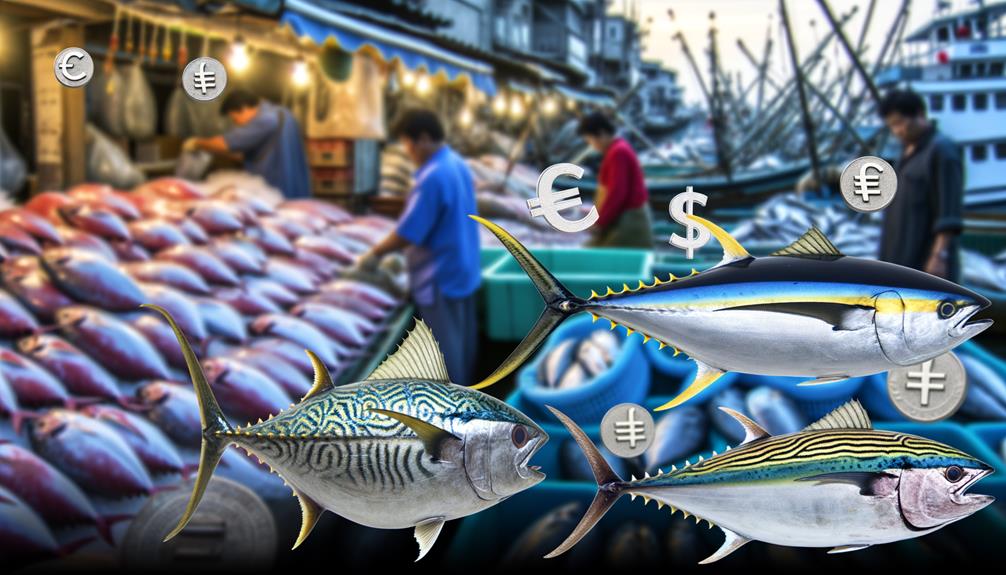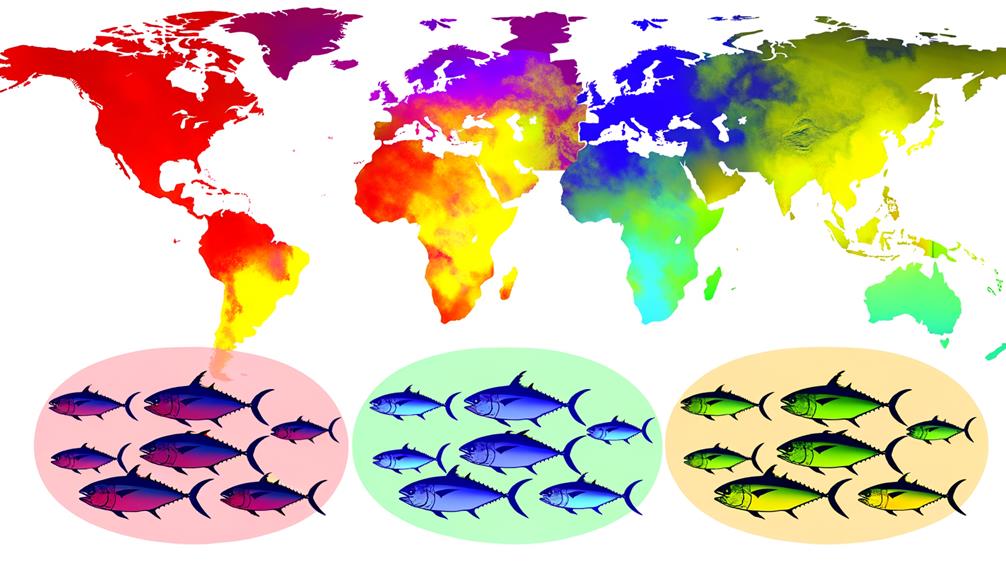You might not think about it when you're enjoying a sushi dinner, but the cost of a single bluefin tuna can skyrocket into the hundreds of thousands of dollars. This isn't your average fish market purchase; the bluefin tuna is considered the king of the sushi world, and its price is influenced by a variety of factors including species, size, quality, and even the current state of the global economy.
You're now probably wondering, 'What makes this fish so expensive and how does it affect the price I pay at the sushi bar?' Well, let's dive into the intriguing world of tuna pricing, it's more fascinating than you might think.
Key Takeaways
- Tuna prices are influenced by factors such as supply and demand dynamics, fishing regulations, quality and freshness, global economic conditions, and seasonality and availability of tuna species.
- Retail prices for tuna are higher than market prices due to additional costs like transportation, storage, and profit margins for retailers.
- The species of tuna, catch method, freshness, quality grade, and cut of the tuna are significant determining factors of tuna prices.
- Bluefin tuna is the most expensive species, followed by yellowfin and albacore, and line-caught tuna is generally considered higher quality and commands higher prices.
Average Annual Tuna Prices
Despite minor fluctuations, the average price of tuna in the U.S. has remained relatively steady from 2011 to 2019, with the cost clocking in at about $0.77 per pound in 2019.
You're probably wondering how this price is calculated. It's based on the average annual tuna prices, which takes into account both the market price and retail price.
The market price of tuna is determined by several factors. For instance, supply and demand dynamics, fishing regulations and quotas, the quality and freshness of the tuna, global economic conditions, and the seasonality and availability of tuna species all play a role in shaping the market price.
On the other hand, the retail price of tuna is what you're likely to encounter in your local grocery store or fish market. It's higher than the market price, reflecting additional costs like transportation, storage, and profit margins for retailers.
In a nutshell, the steadiness of tuna prices over the years speaks to the balance between these various factors. It's comforting to know that, despite the complexities of the global tuna market, you can still count on the price of your favorite fish remaining relatively consistent.
Current Live Tuna Prices
Now that we've explored average annual tuna prices, let's turn our attention to the more specific realm of current live tuna prices, where you'll find a different pricing landscape.
You'll find a wide range in the price of tuna fish, influenced by factors like supply, demand, fishing regulations, and the quality and freshness of the tuna. Importantly, the market value is impacted by global economic conditions and the seasonality and availability of different tuna species.
Consider the current live tuna prices in the U.S., which range from $14.44 – $28.88 per kilogram, or $6.55 – $13.10 per pound at retail, and $10.11 – $20.21 per kilogram, or $4.58 – $9.17 per pound for wholesale.
Here's a handy table to illustrate:
| Retail Prices (per kg) | Wholesale Prices (per kg) | |
|---|---|---|
| Low End | $14.44 | $10.11 |
| High End | $28.88 | $20.21 |
These figures illuminate the complexities of the tuna market, and by understanding this, you can feel more connected to the global community that relies on this vital industry.
Determining Factors of Tuna Prices

Diving into the determining factors of tuna prices, it's crucial to understand that they hinge on a multitude of variables such as the species of tuna, catch method, freshness, quality grade, and the cut of the tuna.
The species of tuna is a significant factor, with bluefin being the most expensive, followed by yellowfin and albacore. The catch method also affects the price as line-caught tuna are generally considered higher quality and thus, fetch higher prices.
Freshness and the quality grade directly influence the price range. The fresher the tuna and the higher the quality grade, the higher the price. Similarly, the cut of the tuna – whether it's belly, tail, or loin – also affects the cost.
Supply and demand dynamics, fishing regulations, global economic conditions, and seasonality and availability of tuna species further impact the determining factors of tuna prices. For instance, when the supply is low due to fishing regulations or seasonality, and the demand is high, the prices increase.
Retail Prices for Tuna Cuts
When it comes to the retail prices for tuna cuts, they fluctuate considerably in the US, with prices varying from $14.44 to $28.88 per kilogram or $6.55 to $13.10 per pound. These shifts are due to several factors, including the high demand for quality tuna and the market conditions.
To give you a clearer picture, let's delve into some significant facts:
- The price in Euros differs, ranging from EUR13.25 to EUR26.49 per kilogram or EUR6.01 to EUR12.01 per pound.
- Wholesale prices are lower, from $10.11 to $20.21 per kilogram or $4.58 to $9.17 per pound.
- International comparison reveals intriguing market variations.
- There's been a noticeable increase in US tuna export prices over the last five years.
- High demand for quality tuna cuts often drives up retail prices.
Understanding these fluctuations helps you navigate the market more effectively. Whether you're a consumer, a retailer, or simply someone interested in the industry, this knowledge can empower you. Remember, you're part of a global community that appreciates the value of this exquisite seafood.
Let's continue to explore the world of tuna together.
Regional and Seasonal Price Differences

Understanding the nuances of regional and seasonal price differences in the tuna market can significantly impact your wallet. These variations stem from factors such as local demand, fishing regulations, economic dynamics, and the seasonal availability of different tuna types.
For example, in Japan, where demand for tuna fish is high, prices can be premium. On the other hand, stricter fishing regulations and quotas in certain regions may decrease tuna supplies, leading to price hikes.
Economic factors and global trade dynamics also play crucial roles in shaping tuna prices. Market fluctuations can cause price variations that ripple across different regions. For instance, an economic downturn in a country that's a major tuna consumer could lower the global tuna price.
Seasonal availability is another key factor in understanding the tuna fish price. This is tied to the migration patterns of different tuna types, with prices often fluctuating based on specific times of the year.
Wholesale Tuna Pricing
Analyzing wholesale tuna pricing, it's clear you must consider factors such as species and size, quality, and market demand to make informed purchasing decisions. Let's delve into the details of how these aspects interact in the tuna market.
- Species and size: Larger tuna fish species, like the Bluefin, command higher prices due to their superior size and taste.
- Quality: The freshness and handling of the catch can significantly influence the price.
- Market demand: Prices fluctuate according to consumer demand and seasonality.
- Auctions: Events like Japan's Tsukiji fish market auction provide a snapshot of wholesale tuna pricing.
- Market conditions: Supply and demand dynamics, location, and even political climate can alter prices.
Understanding the nuances of wholesale tuna pricing allows you to plan strategically and predict market trends. As consumers increasingly lean towards sustainable choices, demand for responsibly sourced tuna is expected to rise. Technology also promises to reshape the industry, with potential impacts on price. Knowing your market and staying ahead of these trends helps ensure you're a competitive player in the tuna trade.
Global Tuna Trade and Price Fluctuations

As you navigate the complexities of the global tuna trade, it's important to note that price fluctuations are influenced by a variety of factors including supply and demand dynamics, fishing regulations, and global economic conditions.
Examining the U.S. market, for instance, shows a relative stability in tuna prices, with an average of about $0.77 per pound in 2019. This stability reflects the intricate balance of global tuna supply and demand, with Thailand being a significant source of tuna imports.
The global tuna market, including a bustling market in Tokyo, isn't static though. Predictions show the canned tuna market growing to over $14 billion by 2025. This illustrates the increasing importance of tuna imports in satisfying the growing demand.
Monitoring these price trends is crucial for making informed buying decisions, strategic planning, and predicting market trends. As someone desiring to belong in this global business, understanding these dynamics is key. It's a complex system, but it's also an opportunity to understand the interconnectedness of our world. Through this, you'll feel more connected to this global commodity and will be better equipped to navigate the market's ebb and flow.
Most Expensive Tuna Species
You're about to explore the realm of the most expensive tuna species, with a particular focus on market values and pricing trends.
First, we'll look at the coveted Bluefin Tuna, often fetching millions at auctions due to its supreme culinary value.
Then, you'll learn about the pricing trends of the Yellowfin Tuna.
Bluefin Tuna Market Value
If you're in the market for bluefin tuna, brace yourself for hefty price tags; this species is extremely valuable, with the highest quality specimens fetching millions at auctions due to their rich, buttery flavor.
The bluefin tuna market value is astronomically high, particularly for the Pacific bluefin tuna. Here are some points to consider:
- In 2019, a Pacific bluefin tuna was auctioned for a record-breaking $3.1 million.
- Overfishing has significantly depleted bluefin stocks, sadly making them scarcer and even more expensive.
- There are serious environmental concerns due to the high demand for these fish.
- Conservation efforts are in place but face extreme challenges.
- The economic impact is profound, especially in Japan, where bluefin is a treasured delicacy.
Yellowfin Tuna Pricing Trends
Shifting our focus from the pricey bluefin, let's explore the pricing trends of yellowfin tuna, another species that's making waves in the global market. As a staple in many diets, yellowfin tuna pricing trends have remained relatively steady, averaging around $0.77 per pound in 2019. This stability, coupled with a strong demand, signals a promising outlook for the yellowfin market.
Now, you might be wondering about live tuna prices. They range from $6.55 to $13.10 per pound at retail and $4.58 to $9.17 per pound at wholesale. Furthermore, with U.S. import prices of live tuna increasing over the past five years, the tuna fish market is set to see substantial growth.
Southern Bluefin: Rare Luxury
Diving into the realm of luxury seafood, Southern Bluefin Tuna stands out as one of the most expensive tuna species, commanding prices that can soar into the millions. This rare luxury isn't just a tuna fish, it's a status symbol, a testament to your refined palate.
Consider these points about Southern Bluefin:
- They're critically endangered, heightening their rarity and value.
- Their high market value makes each catch a potential fortune.
- Japan, with its high demand for premium tuna, is a key buyer.
- Record-breaking purchases have reached unprecedented levels.
- Conservation efforts, while crucial, contribute to their price tag.
In the world of luxury seafood, Southern Bluefin Tuna reigns supreme. Welcome to the club.
Frequently Asked Questions
What Is the Cost of Tuna Fish?
You're looking at varying costs for tuna, depending on factors like sustainability practices and farming costs. Canned tuna prices average around $0.77 per pound, but it can fluctuate due to market conditions.
How Much Does a 700 Lb Tuna Cost?
Considering tuna auctions insights, fishing challenges, and profit margin analysis, a 700lb tuna could cost you between $4,585 and $9,170. It's essential to understand market dynamics to get the best deal.
Is Tuna an Expensive Fish?
Tuna isn't typically an expensive fish, but prices can vary based on factors like quality, location, and demand. Conservation efforts and sustainable fishing practices also impact the tuna market trends.
How Much Is a 800 Lb Bluefin Tuna Worth?
Considering bluefin conservation, tuna fishing methods, and sushi market demand, an 800 lb bluefin tuna could be worth up to $32,000. However, prices can vary greatly based on quality and market conditions.
Conclusion
So, you see, the cost of a tuna fish isn't as straightforward as it seems. It's a complex dance of species, location, market demand, and global conditions.
Picture yourself in a bustling fish market, the air heavy with a salty tang. Whether you're eyeing a steak cut for your grill or sashimi grade for sushi, the price tags reflect this intricate web of factors.
It's a fascinating, fluctuating world that influences each tuna's price tag.
